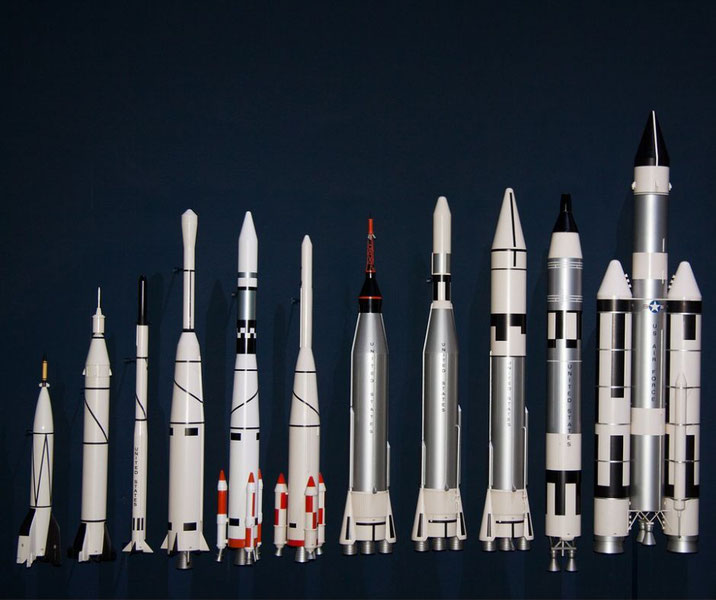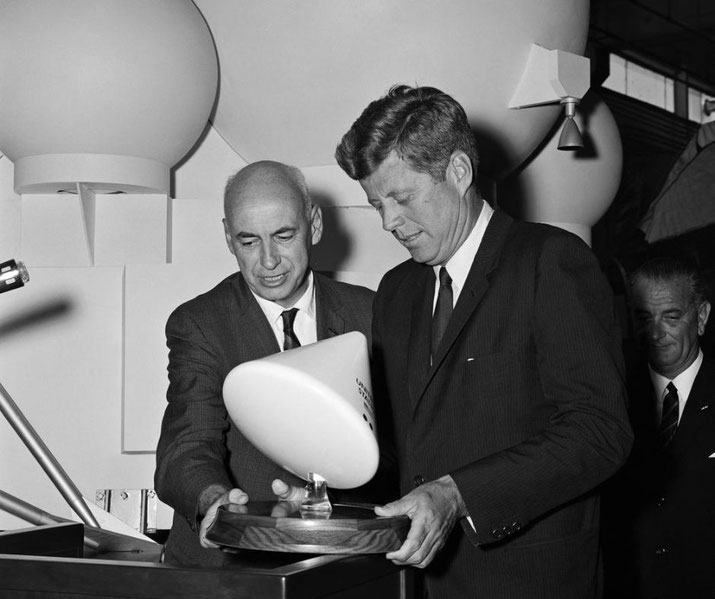Rockets and rivalries: The high-stakes competition of the Cold War 'Space Race'

In the early days of the Cold War, both the United States and the Soviet Union raced to be the first to send a human into space.
This technological rivalry between the two superpowers was known as the 'Space Race'.
The competition to develop the most powerful rocket and technology meant that the Space Race had far-reaching consequences for both countries, including the development of new weaponry and the increased militarisation of space.
World War II origins of the Space Race
Many of the early scientists and engineers with a background in rocket science were German, and the technology these individuals developed was used by both the US and the USSR in the Space Race.
In particular, they had been involved in the development of the V-2 rocket by Nazi Germany during conflict, under the leadership of Wernher von Braun.
However, it was not until after World War Two that the Space Race truly began.
This was due to a number of factors, including the increased competition between the US and USSR following the war, as well as the development of new technologies that made space travel possible.
After the war, von Braun was taken to the United States under Operation Paperclip, where his expertise significantly contributed to the development of American space and missile technology.
Winning the Space Race was considered to be politically important to both countries because it was seen as a way to prove the superiority of their respective political systems.
In addition, the Space Race had military implications, as the development of new rocket technology could be used to create intercontinental ballistic missiles (ICBMs).

The early years of the Space Race
The first steps in the Space Race were taken by both countries in the 1950s, with each launching their own satellites into orbit.
It was the Soviets who achieved the first significant steps in the race. The USSR rocket program was led by the aeronautical engineer called Sergei Korolev.
In the 1950s, Korolev designed the R-7 rocket, which was a large and powerful rocket with the capacity to reach the Moon.
However, it was still too early in the development process to put men into a spacecraft, so they had to develop un-manned craft first.
The very first successful satellite was the Soviet Union's Sputnik I, which was launched on October 4, 1957.
This made worldwide news, and this small device was able to orbit the Earth every 96 minutes.
It was the first artificial Earth satellite, marking a significant achievement in space exploration.
Then, in November 1957, the Soviets launched Sputnik II, their second satellite and the first to contain a living creature: a dog called Laika.
The Soviets were winning the early stages of the Space Race in the late 1950s, and the Americans were desperate to catch up.
The United States' Explorer I was launched on January 31, 1958. In July 1958 President Dwight Eisenhower ordered the formation of a dedicated space agency, the National Aeronautics and Space Administration (NASA).
As a result, NASA was officially established on October 1, 1958, to consolidate and lead the US efforts in space exploration.
In January of 1959, the Soviet Union launched the unmanned first spacecraft to the moon, called Luna 1.
Unfortunately, the technology was still experimental, and it missed its target by around 3,725 miles.
This was followed by the launch of the Luna 2 on the 12th of September 1959, which successfully crashed into the moon on September 14th, just as it was designed to do.
This meant that the USSR was the first to land a man-made device on the moon.
These early successes led to an escalation in the Space Race, with both sides working to develop more powerful rockets and technology.
America began Project Mercury in 1958, which was their first manned spaceflight program.
Height of the Space Race
The Space Race reached its peak in the 1960s, with both sides vying for supremacy in space.
On April 12, 1961, the Soviet Union's Yuri Gagarin became the first human to enter space aboard the Soviet spacecraft Vostok 1. He completed a single orbit of the world in just 108 minutes.
Then, the Soviets sent the first woman into space, Valentina Tereshkova, in June 1963.
She flew aboard Vostok 6 on June 16, 1963, and spent nearly three days in space, during which she orbited Earth 48 times.
However, the United States was not far behind. They sent Alan Shepard on a suborbital flight on May 5, 1961, and John Glenn became the first American to orbit Earth in 1962.
The Soviet achievements sent shockwaves through the United States government and scientific community.
In response, in a speech delivered at Rice University in Houston, Texas, on September 12, 1962, President John F. Kennedy issued a challenge to NASA to put a human on the moon and return him safely to Earth within ten years.
NASA went to work developing the necessary technology and training astronauts for the historic Apollo Moon landing missions.
As a result, Wernher von Braun, the former German rocket engineer, helped design the Saturn V rocket, which powered the Apollo missions.
During this time, they received news that the Soviet Luna 9 had became the first spacecraft to achieve a soft landing on the moon on February 3, 1966.
It had even sent back the very first images from the lunar surface.
Then, the American Apollo 8 program, the first manned mission to leave Earth's orbit and orbit the moon, was launched on the 21st of December 1968.
While the Americans succeeded with the Apollo program, the Soviet Union's manned lunar program faced significant setbacks.
This was particularly true after the death of Sergei Korolev in 1966, which ultimately prevented the USSR from landing a human on the moon.
Then, on July 20, 1969, American astronauts Neil Armstrong and Buzz Aldrin, aboard the Apollo 11 Lunar Module, became the first humans to set foot on the moon.
During this even, Armstrong said his most famous words, "That’s one small step for man, one giant leap for mankind".

The end of the Space Race
The Space Race is generally considered to have tapered off after the Apollo 11 moon landing in 1969.
For many observers, the Space Race finally came to an end after 1972 when the two superpowers signed the Anti-Ballistic Missile Treaty, which limited each country's ability to develop anti-satellite weapons and was an agreement to cooperate in space exploration.
Cooperation between the superpowers in space, such as the Apollo-Soyuz Test Project in 1975, was a sign of how quickly things had changed.
The new cooperation led to some of humanity's greatest achievements, such as the launch of the International Space Station in 1998, a multinational project involving several other countries and space agencies.
While the Space Race may have ended over 40 years ago, its legacy can still be seen today.
The technologies developed during the Space Race have led to advances in fields such as medicine and telecommunications, and resulted in the development of new weapons systems.
The Space Race was a defining event of the Cold War, and its effects are still felt today.
Further reading
What do you need help with?
Download ready-to-use digital learning resources
Copyright © History Skills 2014-2025.
Contact via email
With the exception of links to external sites, some historical sources and extracts from specific publications, all content on this website is copyrighted by History Skills. This content may not be copied, republished or redistributed without written permission from the website creator. Please use the Contact page to obtain relevant permission.





